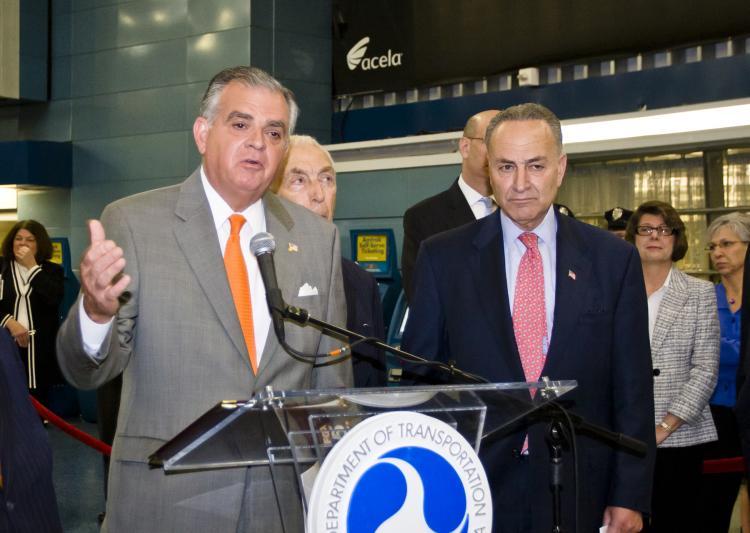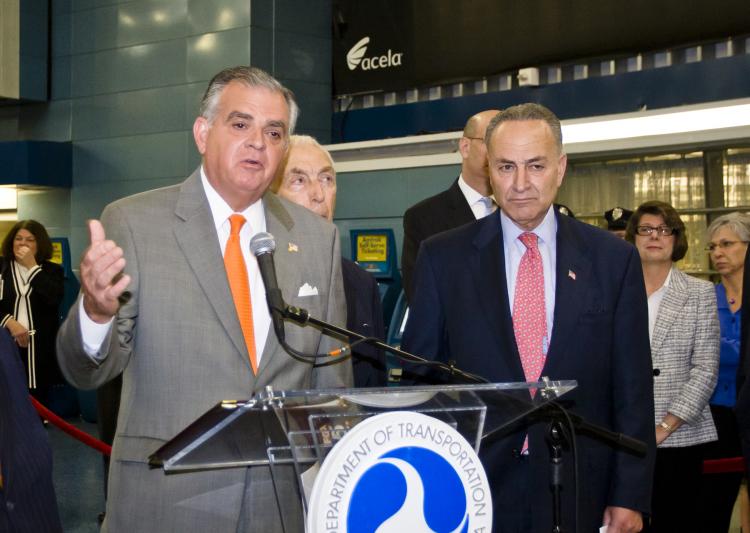NEW YORK—Amtrak trains currently chugging along the Northeast Corridor from Boston to Washington at 135 mph will soon get a $795 million boost to 160 mph.
“Not only can we get from New York to Washington more quickly,” said Sen. Charles Schumer (D-N.Y.) at Penn Station on Monday where U.S. Secretary of Transportation Raymond LaHood announced this federal grant, “but it will [also] ease congestion at our airports, because when more people take rail to Boston, to Philadelphia, to Washington, it clears up the airlines too.”
Congressman Jerrold Nadler (D-N.Y.) added that short-run planes are wasteful and contribute to America’s dependence on foreign oil.
The grant is part of a $2.2 billion federal initiative to improve transportation infrastructure across the nation. The Northeast Corridor gets the king’s share, but Chicago–Detroit, Chicago–St. Louis, and San Francisco–Los Angeles routes will also get a kick-start into the realm of high-speed travel.
New York City stands to benefit from the deal in more ways than one. In addition to quicker trips along the Northeast Corridor, the initiative will connect Boston, Rochester, Syracuse, and New York City with high-speed trains through the Empire State Corridor.
To this end, $58 million will go into a new track at the Albany-Rensselaer station and a new Schenectady station. A new Rochester Intermodal station is also in the planning.
The initiative will clear up the bottleneck at Harold Interlocking in Queens where 783 Amtrak, New Jersey Transit, and Long Island Rail Road (LIRR) trains meet every day.
Sen. Charles Schumer called the interlocking “spaghetti.” With $294.7 million in federal funds, the MTA will build a bypass for Amtrak trains to get the hundreds of thousands of commuters that pass through it daily moving quicker.
Not all states were as eager as New York and New Jersey to take the federal offering. Florida’s Republican Gov. Rick Scott refused the grant, saying he did not want his taxpayers to carry the future burden of operating costs, according to the Miami Herald. House Republicans also tried to shut down Obama’s infrastructure plans, insisting they are too costly.
New York Democrats are unfazed. They see high-speed rail as stimulating the economy, not burdening it.
“Infrastructure is economy,” asserted Nadler, pointing to the thousands of construction jobs created instantly and other jobs created in the long term by businesses sprouting along routes with increased traffic. New York received a share of the grant refused by Florida.
Building infrastructure and improving existing tracks and stations will take time, an estimated eight years. But the plans are shovel-ready and in motion. The 25-year plan is to connect 80 percent of Americans with high-speed rail, explained LaHood, who also pointed out that this is half the time it took to build the interstate system.
Even with the new initiative, Western European and Chinese tracks will still outstrip American high-speed rail. Amtrak’s goal of 165 mph falls significantly short of the 200 mph reached in other nations.
“We couldn’t do it all at once. You couldn’t snap your fingers and go from 90 miles an hour to 220 miles an hour,” said Schumer. “The smart thing to do is start now, realize it is going to take a little while, but every time we do something there’s an improvement and more people ride the rails, there’s less congestion, and so we’re doing it step-by-step.”
“Not only can we get from New York to Washington more quickly,” said Sen. Charles Schumer (D-N.Y.) at Penn Station on Monday where U.S. Secretary of Transportation Raymond LaHood announced this federal grant, “but it will [also] ease congestion at our airports, because when more people take rail to Boston, to Philadelphia, to Washington, it clears up the airlines too.”
Congressman Jerrold Nadler (D-N.Y.) added that short-run planes are wasteful and contribute to America’s dependence on foreign oil.
The grant is part of a $2.2 billion federal initiative to improve transportation infrastructure across the nation. The Northeast Corridor gets the king’s share, but Chicago–Detroit, Chicago–St. Louis, and San Francisco–Los Angeles routes will also get a kick-start into the realm of high-speed travel.
New York City stands to benefit from the deal in more ways than one. In addition to quicker trips along the Northeast Corridor, the initiative will connect Boston, Rochester, Syracuse, and New York City with high-speed trains through the Empire State Corridor.
To this end, $58 million will go into a new track at the Albany-Rensselaer station and a new Schenectady station. A new Rochester Intermodal station is also in the planning.
The initiative will clear up the bottleneck at Harold Interlocking in Queens where 783 Amtrak, New Jersey Transit, and Long Island Rail Road (LIRR) trains meet every day.
Sen. Charles Schumer called the interlocking “spaghetti.” With $294.7 million in federal funds, the MTA will build a bypass for Amtrak trains to get the hundreds of thousands of commuters that pass through it daily moving quicker.
Not all states were as eager as New York and New Jersey to take the federal offering. Florida’s Republican Gov. Rick Scott refused the grant, saying he did not want his taxpayers to carry the future burden of operating costs, according to the Miami Herald. House Republicans also tried to shut down Obama’s infrastructure plans, insisting they are too costly.
New York Democrats are unfazed. They see high-speed rail as stimulating the economy, not burdening it.
“Infrastructure is economy,” asserted Nadler, pointing to the thousands of construction jobs created instantly and other jobs created in the long term by businesses sprouting along routes with increased traffic. New York received a share of the grant refused by Florida.
Building infrastructure and improving existing tracks and stations will take time, an estimated eight years. But the plans are shovel-ready and in motion. The 25-year plan is to connect 80 percent of Americans with high-speed rail, explained LaHood, who also pointed out that this is half the time it took to build the interstate system.
Even with the new initiative, Western European and Chinese tracks will still outstrip American high-speed rail. Amtrak’s goal of 165 mph falls significantly short of the 200 mph reached in other nations.
“We couldn’t do it all at once. You couldn’t snap your fingers and go from 90 miles an hour to 220 miles an hour,” said Schumer. “The smart thing to do is start now, realize it is going to take a little while, but every time we do something there’s an improvement and more people ride the rails, there’s less congestion, and so we’re doing it step-by-step.”







Friends Read Free